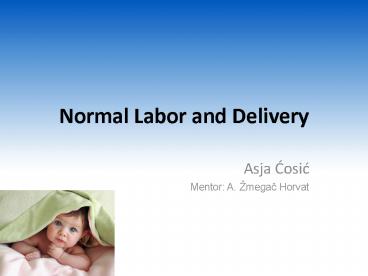Normal Labor and Delivery - PowerPoint PPT Presentation
1 / 12
Title:
Normal Labor and Delivery
Description:
Normal Labor and Delivery Asja osi Mentor: A. mega Horvat Labor labor series of rhythmic, progressive contractions of the uterus gradually move the fetus ... – PowerPoint PPT presentation
Number of Views:1317
Avg rating:3.0/5.0
Title: Normal Labor and Delivery
1
Normal Labor and Delivery
- Asja Cosic
- Mentor A. Žmegac Horvat
2
Labor
- labor
- series of rhythmic, progressive contractions of
the uterus - gradually move the fetus through the cervix and
birth canal - main stages of labor
- first stage labor proper contractions cause
the cervix to dilate and to thin and pull back
(efface) - cervix merges with the rest of the uterus
- second stage delivery of the fetus
- third stage delivery of the placenta
3
Labor
- within 2 weeks before or after the estimated date
of delivery - after 36 weeks a cervical examination is
performed to estimate when labor will start - labor lasts - 12 to 18 hours in a woman's first
pregnancy - - 6 to 8 hours in
subsequent pregnancies - main signs of the start of labor are
- back pain
- contractions in the lower abdomen at regular
intervals - at first contractions may be weak, irregular, and
far apart - with time, they become longer, stronger, and
closer together - bloody show a small discharge of blood mixed
with mucus from the vagina about 72 hours before
contractions start - rupture of membranes the amniotic fluid flows
out through the vagina
4
FIRST STAGE
- from the beginning of labor to the full dilation
of the cervix to about 4 inches (10 cm) - initial (latent) phase
- active phase
5
FIRST STAGE - Initial (Latent) Phase
- contractions become progressively stronger and
more rhythmic - discomfort is minimal
- the cervix thins and opens to approx. 4 cm
- lasts an average of 8½ hours (up to 20 hours) in
a first pregnancy and 5 hours (up to 12 hours) in
subsequent pregnancies
6
FIRST STAGE - Active Phase
- cervix opens to the full 10 centimeters
- fetal presenting part begins to descend into the
mother's pelvis - mother feels urge to push as the baby descends,
but she should resist it - 5 to 7 hours in a first pregnancy and 2 to 4
hours in subsequent pregnancies
7
SECOND STAGE
- from the complete opening of the cervix to
delivery of the fetus - 45 to 60 minutes in first pregnancy
- 15 to 30 minutes in subsequent pregnancies
- during this stage, the woman pushes
8
CARDINAL MOVEMENTS IN LABOR
- Engagement
- Descent
- Flexion
- Internal Rotation
- Extension
- External Rotation
- Expulsion
9
THIRD STAGE
- from delivery of the fetus to delivery of the
placenta - usually lasts only a few minutes but may last up
to 30 minutes - maternal blood loss is limited by contraction of
the uterus - can be managed either expectantly or actively
10
Fourth stage
- can refer to the immediate puerperium, or the
hours immediately after delivery of the placenta
11
Admission to a Hospital or Birthing Center
- strength, duration, and frequency of contractions
are noted - weight, blood pressure, heart and breathing
rates, and temperature are measured - urine and blood samples are taken for analysis
- abdomen is examined to estimate the size,
position and presentation of the fetus - vaginal examination is done to determine whether
the membranes have ruptured and how dilated and
effaced the cervix is - intravenous line to prevent dehydration and for
therapy, if needed - oxytocin or prostaglandin are used to induce
labor - fetal monitoring electronic monitoring is used
to continuously monitor fetal heartbeats and
uterine contractions (CTG)
12
References
http//www.merck.com/ http//en.wikipedia.org/wiki
/Childbirth































